สวัสดีครับ! ผมคือ Michael Zhang นักเดินทางชาวจีนที่รักการสำรวจโลกและมีประสบการณ์ท่องเที่ยวระหว่างประเทศอย่างกว้างขวาง โดยเฉพาะการเดินทางที่เกี่ยวข้องกับประวัติศาสตร์และวัฒนธรรม ผมชอบแบ่งปันประสบการณ์เชิงลึกและมุมมองที่ไม่เหมือนใครจากการเดินทางให้กับทุกคน ในนิทานการเดินทางครั้งนี้ ผมจะพาคุณไปทำความรู้จักกับวัดลามะหยงเหอกง (Yonghe Temple) ในกรุงปักกิ่ง สถานที่ศักดิ์สิทธิ์ที่ผสมผสานประวัติศาสตร์และวัฒนธรรมพุทธศาสนาทิเบตเข้าด้วยกันอย่างลงตัว หวังว่าคู่มือนี้จะช่วยให้คุณเข้าใจวัดอันน่าตื่นตานี้ได้อย่างรอบด้าน และเพิ่มคุณค่าให้กับการเดินทางของคุณมากยิ่งขึ้น
สารบัญบทความ
แนะนำวัดหยงเหอกง
วัดหยงเหอกง ถือเป็นหนึ่งในวัดพุทธศาสนาทิเบตที่เก่าแก่และสมบูรณ์ที่สุดในกรุงปักกิ่ง ความยิ่งใหญ่ของสถาปัตยกรรมที่นี่ไม่เพียงเล่าเรื่องประวัติศาสตร์ช่วงกลางถึงปลายราชวงศ์ชิงเท่านั้น แต่ยังสะท้อนให้เห็นความงดงามของการผสมผสานวัฒนธรรมฮั่นและทิเบตอย่างลงตัว
- ที่อยู่: ถนนหยงเหอกงตง ตะวันออกของกรุงปักกิ่ง (Apple Maps / Amap)
- เวลาเปิดทำการ:
- ฤดูหนาวและฤดูใบไม้ผลิ (1 พ.ย. – 31 มี.ค.): 09:00—16:30 (หยุดขายบัตร 16:00 และปิดพื้นที่ 16:30)
- ฤดูร้อนและฤดูใบไม้ร่วง (1 เม.ย. – 31 ต.ค.): 09:00—17:00 (หยุดขายบัตร 16:30 และปิดพื้นที่ 17:00)
- เวลาเที่ยวที่แนะนำ: 2–3 ชั่วโมง
- ฤดูกาลที่เหมาะสม: เที่ยวได้ตลอดทั้งปี
- ค่าเข้าชม: 25 หยวน
- ซื้อบัตร: ส่วนลด Trip.com, โปรโมชั่น Klook
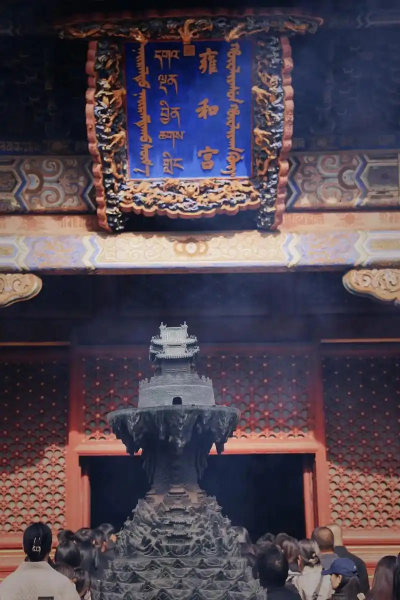
แผนที่วัดหยงเหอกง
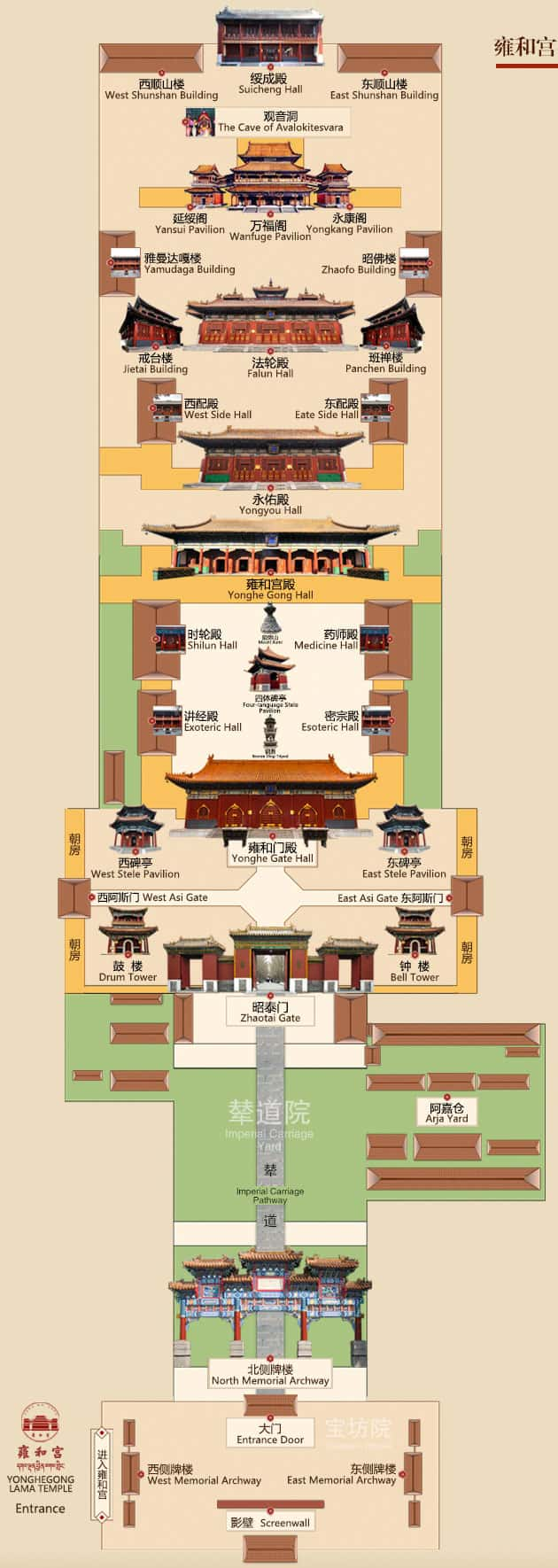
ทำไมต้องไปเที่ยววัดหยงเหอกง?
วัดหยงเหอกงเป็นหนึ่งในแลนด์มาร์กทางประวัติศาสตร์และวัฒนธรรมที่คุณไม่ควรพลาดเมื่อมาเยือนปักกิ่ง โดยเฉพาะผู้ที่สนใจในพุทธศาสนาทิเบต ที่นี่เคยเป็นวัดที่มีเกียรติสูงสุดในช่วงราชวงศ์ชิงตอนกลางถึงปลาย จึงเป็นทั้งศูนย์กลางกิจกรรมทางศาสนา และสถานที่เก็บรักษาศิลปะพุทธทิเบตที่ทรงคุณค่ามากมาย
การมาเยือนที่นี่ คุณจะได้สัมผัสเสน่ห์ทางจิตวิญญาณของพุทธทิเบต พร้อมทั้งชื่นชมงานแกะสลัก จิตรกรรมฝาผนัง และสถาปัตยกรรมที่เต็มไปด้วยคุณค่าทางศิลปะ อีกทั้งยังช่วยเปิดมุมมองใหม่ในการเรียนรู้ความหมายและความงามของวัฒนธรรมพุทธ หากคุณมองหาสถานที่ท่องเที่ยวที่เต็มไปด้วยกลิ่นอายประวัติศาสตร์และความลึกซึ้งทางวัฒนธรรม วัดหยงเหอกงคือคำตอบที่เหมาะสมที่สุดสำหรับการเดินทางของคุณ
ประวัติของวัดหยงเหอกง
วัดนี้มีจุดเริ่มต้นตั้งแต่ปี ค.ศ. 1694 (สมัยจักรพรรดิคังซี) เดิมทีสร้างขึ้นเป็นที่ประทับของโอรสที่สี่ “อิ้นเจิน” ต่อมาในปี ค.ศ. 1725 จึงถูกปรับเปลี่ยนเป็นพระราชวังฤดูร้อน และได้รับพระราชทานชื่อว่า “หยงเหอกง” เมื่อจักรพรรดิหยงเจิ้งสวรรคตในปี ค.ศ. 1735 พระศพถูกอัญเชิญมาประดิษฐานที่นี่ ทำให้หลังคาวัดหลายแห่งถูกเปลี่ยนจากกระเบื้องเคลือบสีเขียวเป็นกระเบื้องเคลือบสีเหลือง ซึ่งเป็นสัญลักษณ์ของความสูงศักดิ์ในราชสำนัก
ด้วยความที่จักรพรรดิเฉียนหลงประสูติ ณ ที่แห่งนี้ วัดหยงเหอกงจึงถูกขนานนามว่า “สถานที่มงคลแห่งจักรพรรดิ” ภายในประกอบด้วยกำแพงสีแดงและหลังคากระเบื้องสีเหลืองที่มีความโอ่อ่าใกล้เคียงพระราชวังต้องห้าม ต่อมาในปี ค.ศ. 1744 วัดหยงเหอกงได้ถูกเปลี่ยนเป็นวัดลามะ และกลายเป็นศูนย์กลางการปกครองศาสนาพุทธทิเบตของราชสำนักชิง ส่งผลให้ที่นี่กลายเป็นวัดที่มีเกียรติสูงสุดของจีนในช่วงราชวงศ์ชิง และยังคงคุณค่าทางประวัติศาสตร์และวัฒนธรรมอันยิ่งใหญ่จนถึงทุกวันนี้
สิ่งที่ต้องทำเมื่อมาเที่ยววัดหยงเหอกง
สถานที่สำคัญภายในวัด
หอมหาเจดีย์ (大殿 – Main Hall)
หอมหาเจดีย์ หรือหอใหญ่ของวัดหยงเหอกง เดิมชื่อว่า “อิ๋นอันเตี้ยน” (銀安殿) ก่อนจะถูกดัดแปลงเป็นวัดลามะ ที่นี่เคยเป็นสถานที่ที่องค์หย่งชินหวัง (เจ้าชายหย่ง) ใช้พบปะขุนนาง ปัจจุบันกลายเป็นพระอุโบสถหลักของวัด เปรียบได้กับวิหารพระประธานของวัดจีนทั่วไป
- พระพุทธรูปสามพระองค์ (三世佛像) : บริเวณทิศเหนือของหอใหญ่ประดิษฐานพระพุทธรูปสัมฤทธิ์สูงราว 2 เมตร 3 องค์ ซึ่งแบ่งออกเป็นสองกลุ่ม
- พระพุทธเจ้าสามองค์แนวนอน (橫三世佛) : พระศากยมุนี (กลาง) พระไภษัชยคุรุพุทธเจ้า (ซ้าย) และพระอมิตาภะ (ขวา) แทนความหมายแห่งพระธรรมที่มีอยู่ทุกหนแห่ง
- พระพุทธเจ้าสามกาลแนวตั้ง (縱三世佛) : พระพุทธเจ้าประทีป (อดีต) พระศากยมุนี (ปัจจุบัน) และพระเมตไตรย (อนาคต) สื่อถึงความต่อเนื่องของพระธรรมในกาลเวลาทั้งสาม
- พระโพธิสัตว์ : มุมตะวันออกเฉียงเหนือและตะวันตกเฉียงเหนือของหอใหญ่ยังมีพระโพธิสัตว์กวนอิมและพระศรีอารยเมตไตรยประดิษฐานอยู่ เสริมบรรยากาศทางศาสนาให้ยิ่งสง่างาม
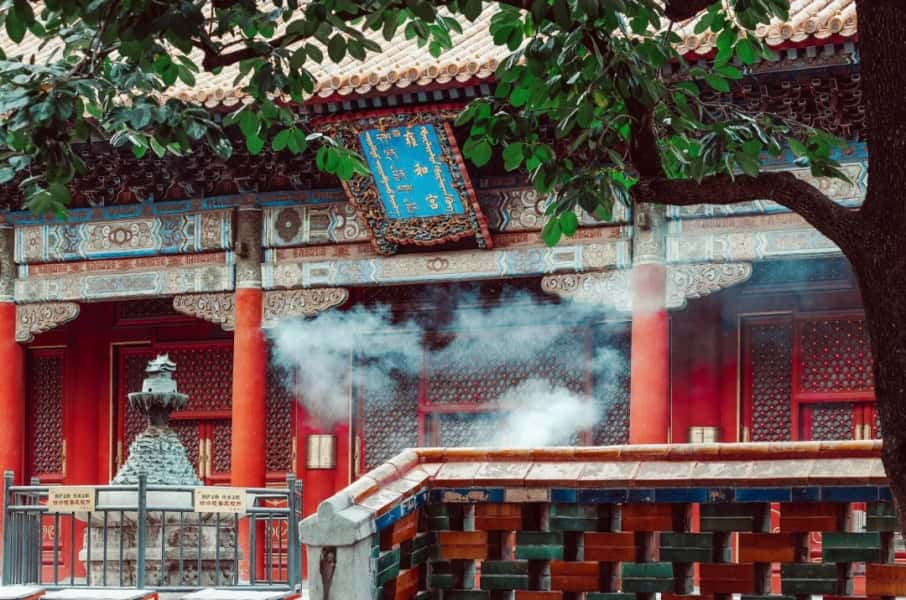
ประตูหยงเหอเหมิน (雍和門)
ตั้งอยู่ระหว่างศาลาจารึกหินสองหลัง เหนือซุ้มประตูมีแผ่นป้ายอักษรที่จักรพรรดิเฉียนหลงทรงจารึกว่า “หยงเหอเหมิน” ถือเป็นซุ้มประตูสำคัญเช่นเดียวกับ “ซานเหมิน” และ “เทียนหวังเตี้ยน” ของวัดพุทธจีน
- สิงโตสำริด : หน้าประตูมีสิงโตสำริดคู่ที่แกะสลักอย่างวิจิตร สะท้อนงานช่างฝีมือสมัยราชวงศ์ชิง
- พระพุทธรูปในวิหาร : ภายในประดิษฐานพระศรีอารยเมตไตรยปางนั่งท้องป่อง ยิ้มอย่างเมตตาบนบัลลังก์มังกรปิดทอง แทนความหมายแห่งความสุขและความหวัง
- พระสี่ทิศ (四大天王) : ทั้งสองด้านประดิษฐานพระสี่ทิศที่ยืนเหยียบอสูร ดูสง่างามและทรงพลัง ด้านหลังมีพระเวทโพธิสัตว์ผู้พิทักษ์ในชุดเกราะ ถืออาวุธ เพื่อปกป้องวัดทั้งมวลให้ร่มเย็น
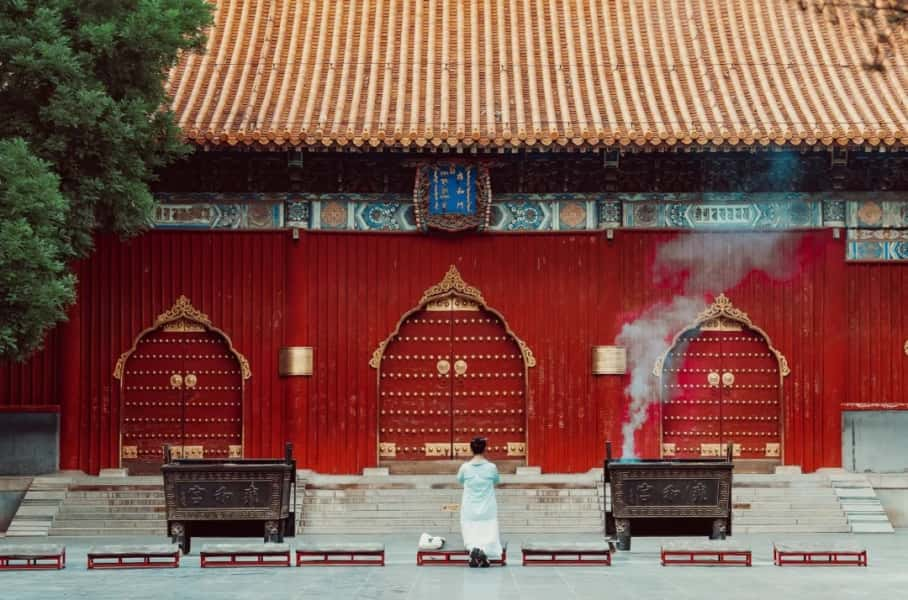
วิหารหยงโหย่วเตี้ยน (永佑殿)
ตั้งอยู่หลังหอใหญ่ ใช้โครงสร้างแบบ “ห้ามืดสิบสว่าง” หมายถึงด้านนอกดูเหมือนห้าห้อง แต่ภายในจริง ๆ มีสิบห้อง
- ประวัติการใช้งาน : ในสมัยยังเป็นวังเจ้าชาย หอหยงโหย่วเคยเป็นห้องหนังสือและห้องบรรทมขององค์หย่งชินหวัง ต่อมาเมื่อแปลงเป็นวัด จึงถูกใช้เป็นที่ประดิษฐานพระศพจักรพรรดิในราชวงศ์ชิง
- ความหมาย : ชื่อ “หยงโหย่ว” มีความหมายอันเป็นสิริมงคล คือขอให้ดวงวิญญาณของกษัตริย์ได้รับการปกป้องตลอดไป แสดงถึงความเคารพของราชวงศ์ต่อบรรพชน
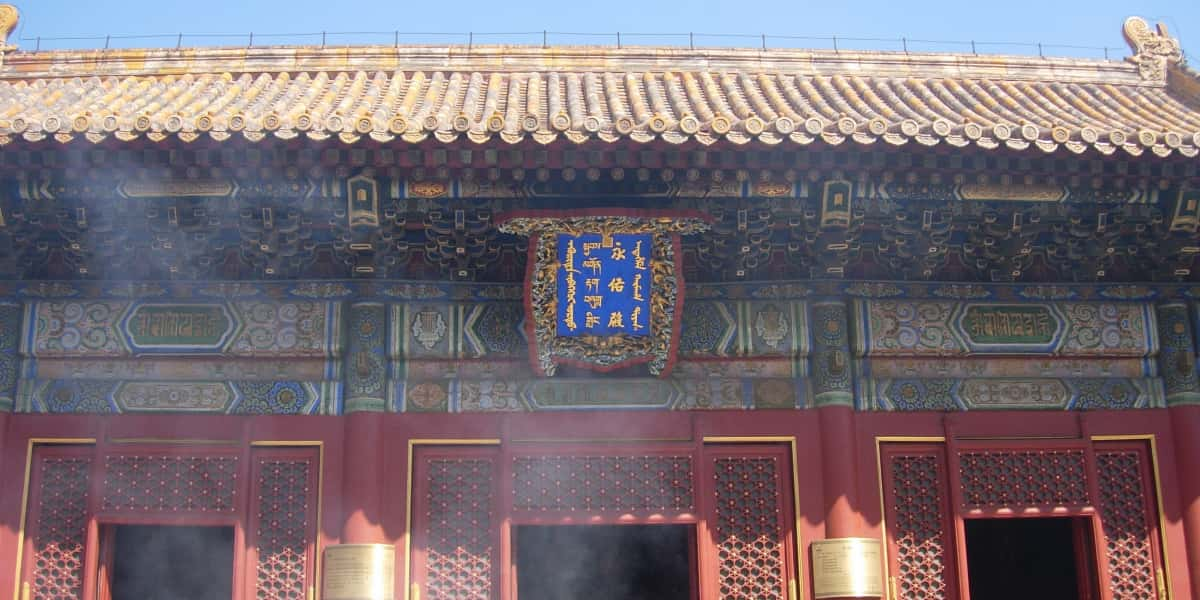
วิหารฝ่าหลุนเตี้ยน (法輪殿)
เป็นสถาปัตยกรรมที่ผสมผสานวัฒนธรรมฮั่นและทิเบตอย่างงดงาม
- พระจงคาปา : ตรงกลางวิหารมีพระพุทธรูปสัมฤทธิ์สูง 6.1 เมตรของพระอาจารย์จงคาปา ผู้ก่อตั้งพุทธศาสนานิกายหมวกเหลือง (เกลุก) พระพักตร์เปี่ยมด้วยรอยยิ้มสงบ ประทับบนดอกบัวใหญ่ แทนปัญญาและเมตตาแห่งพุทธศาสนา
- ภูเขาพระอรหันต์ 500 องค์ : ด้านหลังพระจงคาปามีภูเขาแกะสลักไม้จันทน์แดง สูง 5 เมตร ยาว 3.5 เมตร บนภูเขามีพระอรหันต์ 500 องค์ที่ทำจากทอง เงิน ทองแดง และโลหะอื่น ๆ แต่ละองค์มีท่าทางและสีหน้าแตกต่างกันอย่างมีชีวิตชีวา ถือเป็นสุดยอดงานแกะสลักไม้สมัยราชวงศ์ชิง
- วิหารว่านฝูเก๋อ (万福阁) : ออกจากวิหารฝ่าหลุนจะเห็นอาคารสูง 25 เมตร หลังคาซ้อนสามชั้น ภายในประดิษฐานพระไมเตรียพุทธะ (พระเมตไตรย) สูง 18 เมตร ฝังใต้ดิน 8 เมตร กว้าง 8 เมตร เป็นของกำนัลจากองค์ทะไลลามะองค์ที่ 7 แกะสลักจากไม้จันทน์หอมชิ้นใหญ่ที่สุดในโลก มีตำนานว่าจักรพรรดิเฉียนหลงใช้เงินกว่า 80,000 ตำลึงเงินในการสร้างพระองค์นี้ นับเป็นหนึ่งใน “สามสุดยอดไม้แกะสลัก” ของวัด
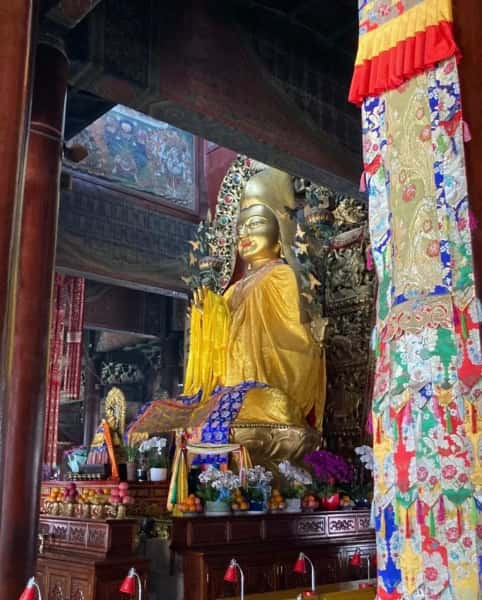
วิหารว่านฝูเก๋อ (万福阁)
เดินต่อจากวิหารฝ่าหลุนเตี้ยนจะพบกับอาคารสูง 25 เมตรที่งดงามอลังการ ภายในประดิษฐานพระไมเตรียพุทธะ (พระเมตไตรย) สูง 18 เมตร กว้าง 8 เมตร ฝังใต้ดิน 8 เมตร สร้างขึ้นจากไม้จันทน์หอมทั้งต้น องค์ทะไลลามะองค์ที่ 7 นำมาถวาย ถือเป็นพระพุทธรูปไม้แกะสลักองค์ใหญ่ที่สุดในจีน ว่ากันว่าจักรพรรดิเฉียนหลงลงทุนมหาศาลกว่า 80,000 ตำลึงเงินเพื่อการแกะสลักครั้งนี้
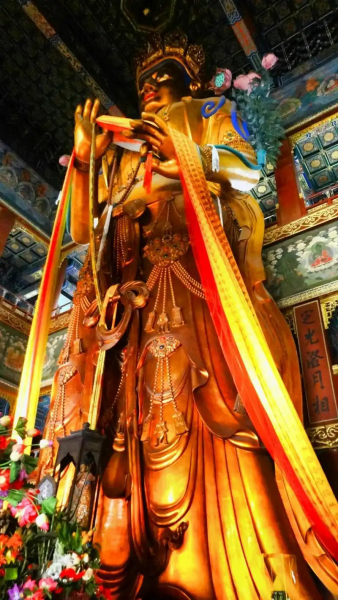
สามสุดยอดงานไม้แกะสลัก (木雕三絕)
- ภูเขาพระอรหันต์ 500 องค์ : อยู่ในวิหารฝ่าหลุนเตี้ยน เป็นผลงานแกะสลักจากไม้จันทน์แดง ภูเขาซับซ้อนสวยงาม บนภูเขามีพระอรหันต์ 500 องค์ทำจากทอง เงิน ทองแดง เหล็ก และดีบุก แต่ละองค์มีอิริยาบถแตกต่างกัน ทั้งนั่ง นอน ยืน หัวเราะ หรือครุ่นคิด งดงามสมจริง แสดงให้เห็นถึงทักษะงานไม้ระดับสูงสุด
- พระไมเตรียพุทธะไม้จันทน์ (檀木大佛) : ตั้งอยู่ในวิหารว่านฝูเก๋อ เป็นพระพุทธรูปแกะสลักจากไม้จันทน์ทั้งต้น สูง 26 เมตร (โผล่พ้นพื้นดิน 18 เมตร) เส้นผ่านศูนย์กลาง 8 เมตร หนักราว 100 ตัน เนื่องจากวัดหยงเหอกงตั้งใกล้วัดไป๋หลิน จักรพรรดิเฉียนหลงจึงโปรดให้สร้างวิหารใหญ่เพื่อบรรจุพระองค์นี้ โดยหวังพึ่งพุทธบารมีเพื่อคุ้มครองราชวงศ์
- แท่นบูชาไม้หอมหยาง (楠木佛龕) : อยู่ในวิหารด้านตะวันออกหน้าว่านฝูเก๋อ แท่นบูชานี้ทำจากไม้หอมหยางทอง ใช้เทคนิคแกะสลักโปร่ง ประดับด้วยมังกรหมู่ 99 ตัว แต่ละตัวมีรายละเอียดงดงาม แสดงพลังและความวิจิตรของศิลปะช่างไม้จีน
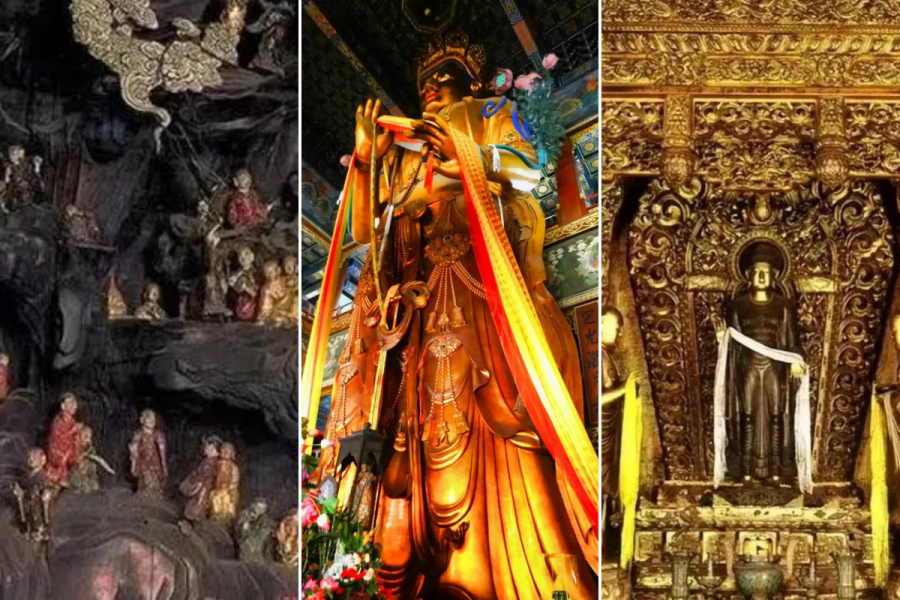
ภูเขาสุเมรุสำริด (銅鑄須彌山)
บริเวณลานหน้าหอใหญ่มีประติมากรรม “ภูเขาสุเมรุ” สำริด สูง 1.5 เมตร ตั้งอยู่บนแท่นหินอ่อนสีขาว ภูเขาสุเมรุเป็นภูเขาศักดิ์สิทธิ์ในตำนานอินเดียโบราณ เชื่อว่าเป็นศูนย์กลางจักรวาล รายละเอียดของงานแกะสลักที่นี่ประณีตยิ่งนัก สะท้อนจักรวาลทัศน์ของพุทธศาสนาได้อย่างลึกซึ้ง
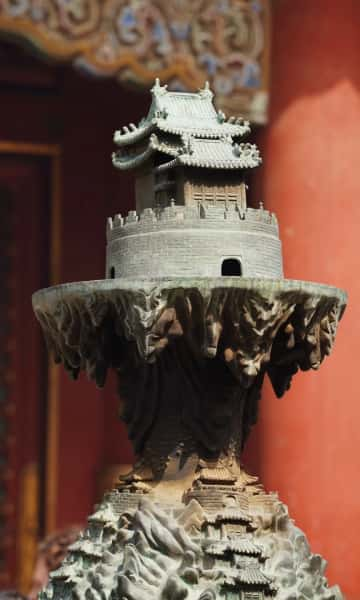
พระพุทธเจ้าสามกาล (竪三世佛)
เดิมประดิษฐานในหออิ๋นอันเตี้ยนของวังหย่งชินหวัง ต่อมาถูกย้ายมาเป็นพระประธานในวัดหยงเหอกง
- รายละเอียดพระพุทธรูป : เป็นพระพุทธรูปสัมฤทธิ์สูงราว 2 เมตร 3 องค์ ตั้งอยู่บนฐานหินอ่อน มีพระอรหันต์ 18 องค์เคียงข้าง
- ความหมายเชิงสัญลักษณ์ : แทนพระพุทธเจ้า 3 กาล ได้แก่ อดีต (พระประทีป) ปัจจุบัน (พระศากยมุนี) และอนาคต (พระเมตไตรย) สื่อถึงการหมุนเวียนของกาลเวลาและพระธรรมที่ไร้ขอบเขต ด้านหลังมีลายมังกรเป็นฉัพพรรณรังสี เปรียบดังแสงธรรมที่แผ่ไปทั่วโลก
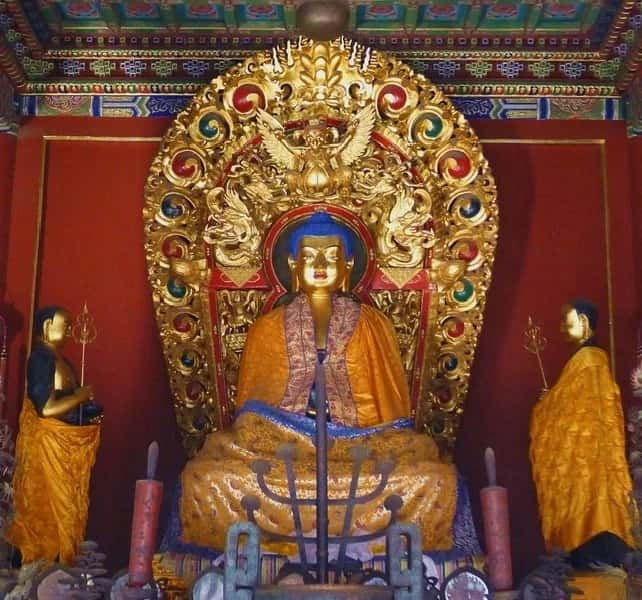
ภาพวงล้อแห่งสังสารวัฏ (六道輪迴圖)
ในวิหารด้านตะวันออกของว่านฝูเก๋อ มีภาพพุทธศิลป์ที่สำคัญ 2 ภาพ หนึ่งในนั้นคือ “ภาพหกภูมิแห่งการเวียนว่ายตายเกิด”
- การตีความ : ภาพนี้แสดงวงจรชีวิตของสรรพสัตว์ที่เวียนว่ายในหกภูมิ ได้แก่ เทพ มนุษย์ อสูร เดรัจฉาน เปรต และนรก สื่อถึงหลักพุทธที่ว่าทุกชีวิตมีโอกาสเท่าเทียมในวัฏสงสาร
- ประวัติ : เดิมเป็นภาพที่พระมารดาของจักรพรรดิเฉียนหลงถวายบูชาแก่พระพุทธรูป ภาพนี้ไม่เพียงทรงคุณค่าทางศิลปะ แต่ยังสะท้อนปรัชญาพุทธเรื่องความเสมอภาคของสรรพชีวิตได้อย่างลึกซึ้ง
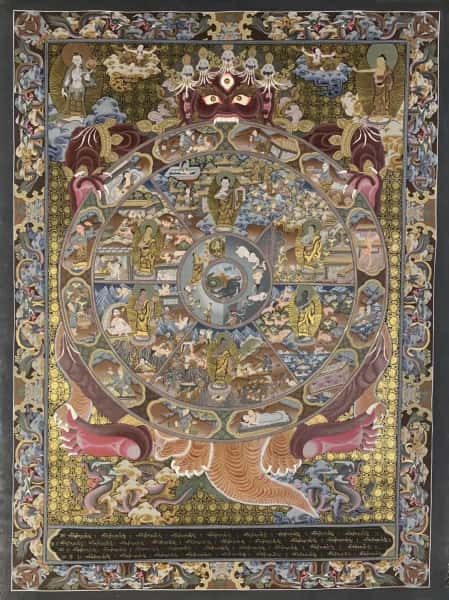
คู่มือบัตรเข้าชมวัดหยงเหอกง
ราคาบัตรเข้าชม
- ราคา :
- ผู้ใหญ่: 25 หยวน (บัตรครึ่งราคา 12 หยวน)
- เด็ก: 12 หยวน (อายุ 6–18 ปี)
- ผู้สูงอายุ: 12 หยวน (อายุ 60 ปีขึ้นไป)
- ฟรีบัตร : เด็กอายุไม่เกิน 6 ปี หรือส่วนสูงไม่เกิน 1.2 เมตร เข้าชมฟรี
เวลาเปิดทำการ
- ฤดูหนาวและฤดูใบไม้ผลิ : 1 พ.ย. – 31 มี.ค. เวลา 09:00—16:30 (ปิดขายบัตร 16:00 และปิดพื้นที่ 16:30)
- ฤดูร้อนและฤดูใบไม้ร่วง : 1 เม.ย. – 31 ต.ค. เวลา 09:00—17:00 (ปิดขายบัตร 16:30 และปิดพื้นที่ 17:00)
วิธีซื้อตั๋ว
- ออนไลน์ : ผ่านทาง WeChat Official Account หรือแพลตฟอร์มจองตั๋ว
- ซื้อบัตร: ส่วนลด Trip.com, โปรโมชั่น Klook
- ออฟไลน์ : ซื้อบัตรกระดาษได้ที่ “ศูนย์บริการตั๋ว”
บริการไกด์ทัวร์ของวัดหยงเหอกง
วัดหยงเหอกงมีบริการไกด์นำชมอย่างมืออาชีพ มีให้เลือก 3 ภาษา ได้แก่ ภาษาจีน ภาษาอังกฤษ และภาษาเยอรมัน เหมาะทั้งนักท่องเที่ยวแบบเดี่ยวและแบบกลุ่ม
- ไกด์ภาษาจีน :
- 1–3 คน : 100 หยวน
- 4–6 คน : 200 หยวน
- 7–10 คน : 300 หยวน
- ไกด์ภาษาอังกฤษ :
- 1–3 คน : 200 หยวน
- 4–6 คน : 400 หยวน
- 7–10 คน : 500 หยวน
- ระยะเวลา : ประมาณ 40 นาที
- จุดเริ่มบริการ : บริเวณทางเข้าวัดหยงเหอกง
คู่มือการไหว้ขอพรและการถวายธูปที่วัดหยงเหอกง
วัดหยงเหอกงขึ้นชื่อในด้านบรรยากาศที่เคร่งขรึมและศักดิ์สิทธิ์ จึงเป็นจุดหมายยอดนิยมสำหรับผู้ศรัทธาและนักท่องเที่ยวที่ต้องการขอพรและเสริมสิริมงคล ต่อไปนี้คือขั้นตอนการถวายธูปและขอพรแบบดั้งเดิมที่จะช่วยให้คุณสัมผัสประสบการณ์ทางวัฒนธรรมได้ลึกซึ้งยิ่งขึ้น
การรับและมารยาทในการใช้ธูป
- บริเวณสองข้างประตูจ้าวไถเหมิน มีจุดแจกธูปฟรี โดยแต่ละชุดจะระบุชัดว่า “ถวายธูป 3 ดอกกำลังเหมาะสม” ควรจุดเพียง 3 ดอกเพื่อบูชาพระ
- หากเปลวไฟแรงเกินไป ควรใช้มือโบกเบา ๆ เพื่อดับไฟ ห้ามใช้ปากเป่า เพราะถือว่าเป็นการไม่ให้เกียรติและทำให้ความบริสุทธิ์ของธูปลดลง
ขั้นตอนการไหว้พระและขอพร
- เริ่มจากวิหารหลัก : ไหว้ที่วิหารประธานก่อน ประนมมือและแสดงความเคารพอย่างตั้งใจ
- เวียนตามเข็มนาฬิกา : เดินเวียนไปยังวิหารด้านตะวันออกและตะวันตกตามลำดับ กราบพระประธานในแต่ละวิหาร พร้อมกล่าวคำอธิษฐานในใจ
มารยาทในการเข้าวิหาร
- ผู้ชายก้าวเท้าซ้ายก่อนเมื่อเข้าสู่วิหาร ส่วนผู้หญิงให้ก้าวเท้าขวาก่อน
- ประตูตรงกลางถือเป็น “ทางพระพุทธเจ้า” จึงควรใช้ประตูด้านข้างเข้าออกเพื่อแสดงความเคารพต่อพระพุทธศาสนา
ความหมายของการขอพรในแต่ละวิหาร
- ขอความสุขและความราบรื่น : วิหารหยงเหอเหมิน
- ขอโชคลาภ : วิหารใหญ่ของวัดหยงเหอกง
- ขับไล่เคราะห์ภัย : วิหารหยงโหย่วเตี้ยน
- ขอความก้าวหน้าในหน้าที่การงาน : วิหารฝ่าหลุนเตี้ยน
- ขอความปลอดภัยและสันติสุข : วิหารว่านฝูเก๋อ
จุดจำหน่ายวัตถุมงคลและธูป 3 แห่ง
- ด้านตะวันตกนอกประตูตรวจตั๋ว
- ด้านซ้ายของประตูจ้าวไถเหมิน
- ด้านขวาของหอมหาเจดีย์ (วิหารใหญ่)
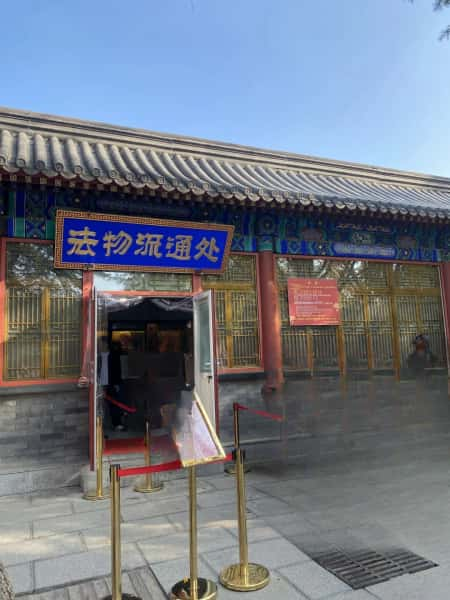
กิจกรรมทางศาสนาพุทธในวัดหยงเหอกง
- พิธีสวดมนต์วันมงคลพระพุทธเจ้า : จัดขึ้นระหว่างวันที่ 13–15 เดือน 4 ตามปฏิทินจันทรคติ เป็นเทศกาลสำคัญของพุทธศาสนาทิเบต เพื่อรำลึกถึงการประสูติ การตรัสรู้ และการปรินิพพานของพระพุทธเจ้า
- พิธีอธิษฐานมหาปณิธาน : จัดขึ้นระหว่างวันที่ 23 เดือนอ้าย ถึงวันที่ 1 เดือน 2 ตามปฏิทินจันทรคติ ภายในงานมีการแสดงระบำเทพเจ้าวัชรปราบมารที่ตื่นตาตื่นใจ
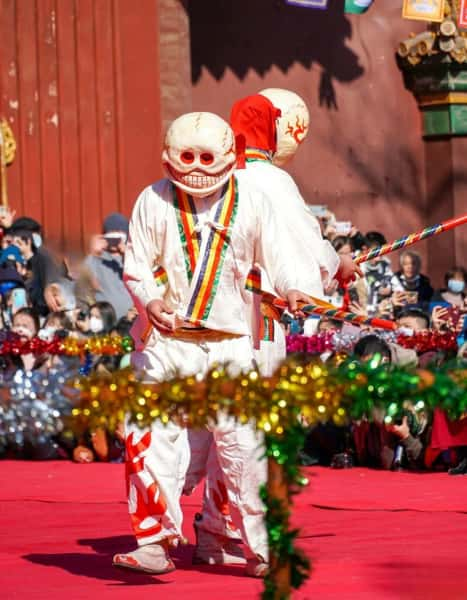
- พิธีสวดมนต์ท่านวัชรวีระ (大威德金剛壇城法會) : จัดขึ้นระหว่างวันที่ 24–30 กันยายน ตามปฏิทินสุริยคติ แสดงให้เห็นพิธีกรรมอันลึกซึ้งของพุทธศาสนาทิเบต
- พิธีบูชาพระอาจารย์จงคาปา : จัดขึ้นวันที่ 25 เดือน 10 ตามปฏิทินจันทรคติ เพื่อรำลึกถึงคุณูปการและปัญญาธรรมของพระอาจารย์จงคาปา
- กิจกรรมแจกข้าวต้ม (舍粥活動) : จัดขึ้นวันที่ 8 เดือน 12 ตามปฏิทินจันทรคติ เพื่อระลึกถึงวันที่พระศากยมุนีตรัสรู้
เส้นทางแนะนำในการเที่ยวชมวัดหยงเหอกง
เส้นทางที่เหมาะกับผู้มาเยือนครั้งแรก :
ประตูตรวจตั๋ว → ศูนย์จำหน่ายวัตถุมงคล → จุดรับธูป → วิหารหยงเหอเหมิน (ขอพรความปลอดภัย) → วิหารหยงโหย่ว (ปัดเป่าเคราะห์ภัย) → ห้องเปิดพระเนตร (ด้านตะวันตกของวิหารหยงโหย่ว) → วิหารฝ่าหลุน (ขอโชคลาภและหน้าที่การงาน) → วิหารว่านฝูเก๋อ (ขอพรความรักและบุตร) → วิหารเฉิงเตี้ยน (ขอพรสิริมงคล) → ประตูเล็กฝั่งตะวันตกออก
เส้นทางนี้ครอบคลุมวิหารหลักทั้งหมดของวัด ทั้งด้านการท่องเที่ยวและการขอพร
วิธีเดินทางจากใจกลางกรุงปักกิ่งไปยังวัดหยงเหอกง
รถไฟใต้ดิน
วิธีเดินทางที่สะดวกที่สุดคือการใช้รถไฟใต้ดิน
- สาย 2 : ลงที่สถานีหยงเหอกง ออกทางออก C เดินต่อประมาณ 5 นาทีถึงประตูวัด
- สาย 5 : ลงที่สถานีหยงเหอกงเช่นกัน ออกทางออก F แล้วเดินต่อไม่กี่นาที
รถประจำทาง
มีหลายสายที่ผ่านวัดหยงเหอกงโดยตรง
- ใช้รถเมล์สาย 13, 116 หรือ 684 ลงที่ป้ายหยงเหอกง เดินต่อประมาณ 3–5 นาทีถึงประตูหลัก
- คำแนะนำ : ป้ายรถเมล์รอบ ๆ วัดมีหลายจุด ควรตรวจสอบเส้นทางและตารางเวลารถก่อนขึ้นเพื่อความสะดวก
ร้านอาหารแนะนำใกล้วัดหยงเหอกง
- ร้านชี๋เซวียนปาเจ่า·อาหาร胡同 (七尋八找·胡同菜)
- ที่อยู่ : เลขที่ 1 ซอย 2 โรงละคร胡同 เขตตงเฉิง กรุงปักกิ่ง (อยู่ทางทิศใต้ของกำแพงวัดหยงเหอกง ประมาณ 200 เมตร)
- ค่าใช้จ่ายเฉลี่ย : 90 หยวน/คน
- เหตุผลที่แนะนำ :
- บริการอาหารพื้นบ้านปักกิ่งแท้ ๆ
- เมนูแนะนำ : ไก่ “จี๋หลี่ป้ง” (รสกลมกล่อม เนื้อสัมผัสหลากหลาย), มันฝรั่งผัดไข่ไก่บ้าน (กรอบหอม), มันบดไอศกรีม (เสิร์ฟคู่ไอศกรีมวานิลลา แปลกใหม่ไม่ซ้ำใคร)
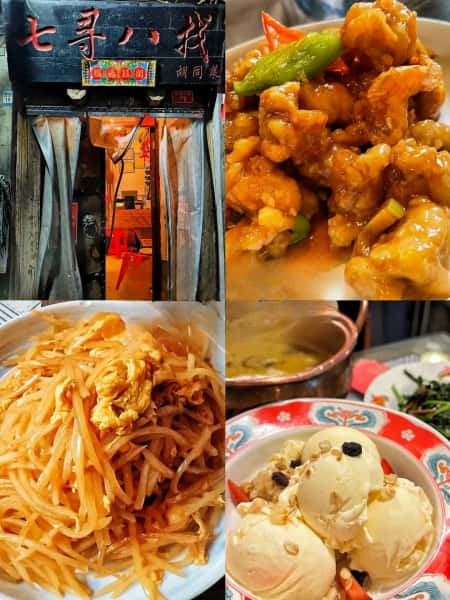
- ร้านซินเหอเสี่ยวกวาน (新和小館 – สาขาเป่ยซินเฉียว)
- ที่อยู่ : 155 ถนนหยงเหอกง
- ค่าใช้จ่ายเฉลี่ย : 70 หยวน/คน
- เหตุผลที่แนะนำ :
- ร้านราคาคุ้มค่า เหมาะสำหรับครอบครัวหรือรับประทานแบบง่าย ๆ
- เมนูแนะนำ : เกี๊ยวทอดสามรส (ไส้สดใหม่แน่น), หมูผัดพริกหอมรสเปรี้ยวหวาน (魚香肉絲), หมูเปรี้ยวหวาน (糖醋里脊), แตงกวาดองมีดตาข่าย (簑衣黃瓜) หอมสดชื่น
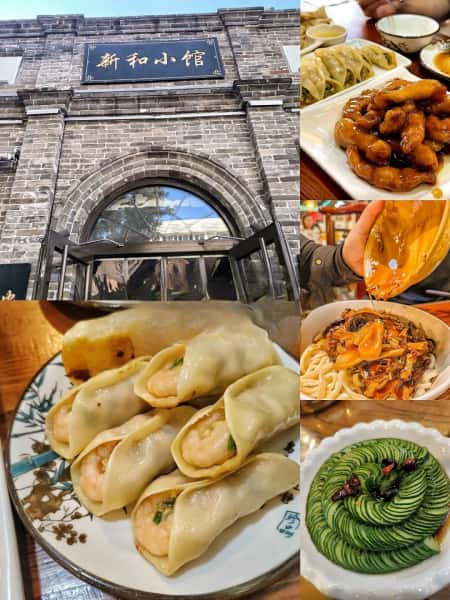
- ร้านหม่า ซาน มันฝรั่งทอด (馬三洋芋片 – สาขากุ้ยเจีย)
- ที่อยู่ : บ้านเลขที่ 185 ถนนหยงเหอกง อาคาร 1–3
- ค่าใช้จ่ายเฉลี่ย : 40 หยวน/คน
- เหตุผลที่แนะนำ :
- มันฝรั่งทอดกรอบหอม รสเผ็ดจัดจ้าน กินเพลิน
- ของหวานแนะนำ : “ไข่นมหวาน” (奶雞蛋醪糟) รสหวานละมุน เนื้อสัมผัสนุ่มนวล
คำถามที่พบบ่อย
สามารถ แต่ควรระวัง เนื่องจากภายในวัดเป็นสถาปัตยกรรมเก่า มีบันไดหลายจุดและขาดทางราบ อาจไม่สะดวกสำหรับรถเข็นเด็ก
ไม่มีจุดฝากสัมภาระอย่างเป็นทางการ แต่มีร้านค้าใกล้ทางเข้าที่ให้บริการฝากของ ราคาประมาณ 8–15 หยวน/ชิ้น
ตำแหน่ง : เลขที่ 83 ถนนหยงเหอกง ตรงข้ามจุดตรวจบัตรทางเข้า
พื้นที่กลางแจ้งสามารถถ่ายได้ แต่ภายในวิหารห้ามถ่ายรูป เพื่อความเคารพต่อพิธีกรรมและพระพุทธรูป
เนื่องจากวัดเป็นอาคารโบราณ บางส่วนไม่มีทางลาด รถเข็นอาจต้องมีผู้ช่วย อย่างไรก็ตาม บริเวณทางเข้ามีพนักงานคอยช่วยเหลือ
ห้ามนำอาหารและเครื่องดื่มเข้าไปในวัด เพื่อรักษาความสะอาดและบรรยากาศที่ศักดิ์สิทธิ์ แนะนำให้ไปรับประทานอาหารที่ร้านใกล้เคียงหลังจากเที่ยวเสร็จ
รวมลิงก์แนะนำเที่ยวปักกิ่งที่จำเป็น
- คู่มือเที่ยวปักกิ่งฉบับสมบูรณ์ 📖
- แนะนำสถานที่ท่องเที่ยวและแผนเที่ยวปักกิ่ง🏙️
- แนะนำที่พัก 🏨
- คู่มือการเดินทาง ✈️ 🚇 🚄 🚆
- เคล็ดลับและข้อมูลจำเป็นในการท่องเที่ยว 🗺️ 🍜 📱 💸 🌤️ 💊
- 🗺️ แผนที่ปักกิ่ง
- 🍜 แนะนำอาหารอร่อยในปักกิ่ง
- 🍜 คู่มือร้านเป็ดปักกิ่ง
- 📱 แอปพลิเคชันจำเป็นสำหรับการท่องเที่ยว
- 💸 คู่มือขอคืนภาษี (Tax Refund) ในจีน
- 🌤️ ข้อมูลสภาพอากาศปักกิ่ง
- 💊 รายการยาจำเป็นที่ควรนำไปเที่ยวจีน
- 🛍️ ดีลท่องเที่ยวในประเทศจีน
- 🔌 ปลั๊กจีน แรงดันไฟฟ้า และคู่มือปลั๊กไฟจีน
- 📶 วิธีการใช้ eSIM ในประเทศจีน
- 🧳 รายการบรรจุภัณฑ์และเช็คลิสต์การเดินทาง

 English (US)
English (US)  繁體中文
繁體中文 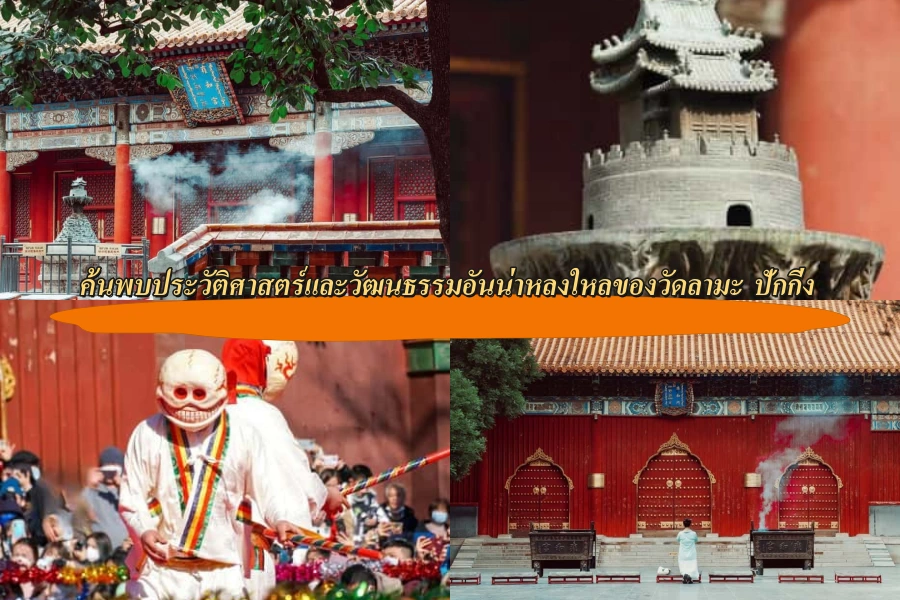
Comment (0)